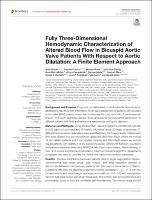| dc.contributor | Vall d'Hebron Barcelona Hospital Campus |
| dc.contributor.author | Sotelo, Julio |
| dc.contributor.author | Franco, Pamela |
| dc.contributor.author | Evangelista Masip, Artur |
| dc.contributor.author | Guala, Andrea |
| dc.contributor.author | Dux-Santoy Hurtado, Lydia |
| dc.contributor.author | Rodríguez Palomares, Jose Fernando |
| dc.contributor.author | Ruiz Muñoz, Aroa |
| dc.date.accessioned | 2022-09-08T12:01:01Z |
| dc.date.available | 2022-09-08T12:01:01Z |
| dc.date.issued | 2022-05 |
| dc.identifier.citation | Sotelo J, Franco P, Guala A, Dux-Santoy L, Ruiz-Muñoz A, Evangelista A, et al. Fully Three-Dimensional Hemodynamic Characterization of Altered Blood Flow in Bicuspid Aortic Valve Patients With Respect to Aortic Dilatation: A Finite Element Approach. Front Cardiovasc Med. 2022 May;9:885338. |
| dc.identifier.issn | 2297-055X |
| dc.identifier.uri | https://hdl.handle.net/11351/8078 |
| dc.description | Bicuspid aortic valve; Congenital heart disease; Magnetic resonance imaging |
| dc.description.abstract | Background and Purpose: Prognostic models based on cardiovascular hemodynamic parameters may bring new information for an early assessment of patients with bicuspid aortic valve (BAV), playing a key role in reducing the long-term risk of cardiovascular events. This work quantifies several three-dimensional hemodynamic parameters in different patients with BAV and ranks their relationships with aortic diameter.
Materials and Methods: Using 4D-flow CMR data of 74 patients with BAV (49 right-left and 25 right-non-coronary) and 48 healthy volunteers, aortic 3D maps of seventeen 17 different hemodynamic parameters were quantified along the thoracic aorta. Patients with BAV were divided into two morphotype categories, BAV-Non-AAoD (where we include 18 non-dilated patients and 7 root-dilated patients) and BAV-AAoD (where we include the 49 patients with dilatation of the ascending aorta). Differences between volunteers and patients were evaluated using MANOVA with Pillai's trace statistic, Mann–Whitney U test, ROC curves, and minimum redundancy maximum relevance algorithm. Spearman's correlation was used to correlate the dilation with each hemodynamic parameter.
Results: The flow eccentricity, backward velocity, velocity angle, regurgitation fraction, circumferential wall shear stress, axial vorticity, and axial circulation allowed to discriminate between volunteers and patients with BAV, even in the absence of dilation. In patients with BAV, the diameter presented a strong correlation (> |+/−0.7|) with the forward velocity and velocity angle, and a good correlation (> |+/−0.5|) with regurgitation fraction, wall shear stress, wall shear stress axial, and vorticity, also for morphotypes and phenotypes, some of them are correlated with the diameter. The velocity angle proved to be an excellent biomarker in the differentiation between volunteers and patients with BAV, BAV morphotypes, and BAV phenotypes, with an area under the curve bigger than 0.90, and higher predictor important scores.
Conclusions: Through the application of a novel 3D quantification method, hemodynamic parameters related to flow direction, such as flow eccentricity, velocity angle, and regurgitation fraction, presented the best relationships with a local diameter and effectively differentiated patients with BAV from healthy volunteers. |
| dc.language.iso | eng |
| dc.publisher | Frontiers Media |
| dc.relation.ispartofseries | Frontiers in Cardiovascular Medicine;9 |
| dc.rights | Attribution 4.0 International |
| dc.rights.uri | http://creativecommons.org/licenses/by/4.0/ |
| dc.source | Scientia |
| dc.subject | Cor - Vàlvules - Malalties - Imatgeria |
| dc.subject | Monitoratge hemodinàmic |
| dc.subject | Aneurismes aòrtics |
| dc.subject.mesh | Heart Valve Diseases |
| dc.subject.mesh | /diagnostic imaging |
| dc.subject.mesh | Hemodynamics |
| dc.subject.mesh | Dilatation, Pathologic |
| dc.title | Fully Three-Dimensional Hemodynamic Characterization of Altered Blood Flow in Bicuspid Aortic Valve Patients With Respect to Aortic Dilatation: A Finite Element Approach |
| dc.type | info:eu-repo/semantics/article |
| dc.identifier.doi | 10.3389/fcvm.2022.885338 |
| dc.subject.decs | enfermedades de las válvulas cardíacas |
| dc.subject.decs | /diagnóstico por imagen |
| dc.subject.decs | hemodinámica |
| dc.subject.decs | dilatación patológica |
| dc.relation.publishversion | https://doi.org/10.3389/fcvm.2022.885338 |
| dc.type.version | info:eu-repo/semantics/publishedVersion |
| dc.audience | Professionals |
| dc.contributor.organismes | Institut Català de la Salut |
| dc.contributor.authoraffiliation | [Sotelo J] School of Biomedical Engineering, Universidad de Valparaíso, Valparaíso, Chile. Biomedical Imaging Center, Pontificia Universidad Católica de Chile, Santiago, Chile. Millennium Institute for Intelligent Healthcare Engineering, iHEALTH, Santiago, Chile. Millennium Nucleus in Cardiovascular Magnetic Resonance, Cardio MR, Santiago, Chile. [Franco P] Biomedical Imaging Center, Pontificia Universidad Católica de Chile, Santiago, Chile. Millennium Institute for Intelligent Healthcare Engineering, iHEALTH, Santiago, Chile. Millennium Nucleus in Cardiovascular Magnetic Resonance, Cardio MR, Santiago, Chile. Department of Electrical Engineering, Pontificia Universidad Católica de Chile, Santiago, Chile. [Guala A, Dux-Santoy L, Ruiz-Muñoz A, Evangelista A, Rodríguez-Palomares JF] Servei de Cardiologia, Vall d'Hebron Hospital Universitari, Barcelona, Spain. Vall d'Hebron Institut de Recerca (VHIR), Barcelona, Spain. CIBER-CV, Barcelona, Spain |
| dc.identifier.pmid | 35665243 |
| dc.identifier.wos | 000806127300001 |
| dc.relation.projectid | info:eu-repo/grantAgreement/ES/PE2017-2020/IJC2018-037349-I |
| dc.rights.accessrights | info:eu-repo/semantics/openAccess |

